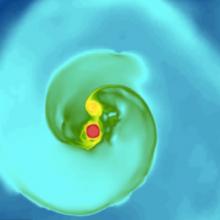
Description
Binary companions are likely required to explain bipolar shaping in post-Asymptotic Giant Branch and Planetary Nebula outflows. Observationally, determination of the fraction of systems harboring binaries is difficult as obscuration and pulsation mask binary signatures. We propose a theoretical study of an indirect signature: jet precession induced by a binary companion. We have selected 13 HST archival images of evolved stars which show clear evidence of jet precession. For each object, we will determine the binary parameters required to match the precession frequency including the companion mass, separation and outer accretion disk radius. In addition, we will numerically simulate binary-induced precession using the 3-D, hydrodynamic code FLASH. The simulation data will be compared to observations via use of the morpho-kinetic code SHAPE. This work will provide unique constraints on binary precession scenarios in evolved stars and is applicable to other systems which exhibit precession in their jets including: young stellar objects, active galactic nuclei and compact binaries.Binary companions are likely required to explain bipolar shaping in post-Asymptotic Giant Branch and Planetary Nebula outflows. Observationally, determination of the fraction of systems harboring binaries is difficult as obscuration and pulsation mask binary signatures. We propose a theoretical study of an indirect signature: jet precession induced by a binary companion. We have selected 13 HST archival images of evolved stars which show clear evidence of jet precession. For each object, we will determine the binary parameters required to match the precession frequency including the companion mass, separation and outer accretion disk radius. In addition, we will numerically simulate binary-induced precession using the 3-D, hydrodynamic code FLASH. The simulation data will be compared to observations via use of the morpho-kinetic code SHAPE. This work will provide unique constraints on binary precession scenarios in evolved stars and is applicable to other systems which exhibit precession in their jets including: young stellar objects, active galactic nuclei and compact binaries.